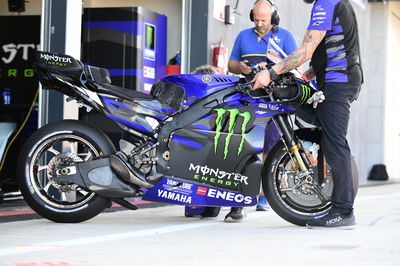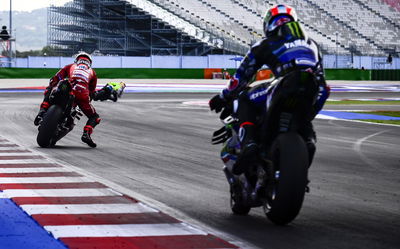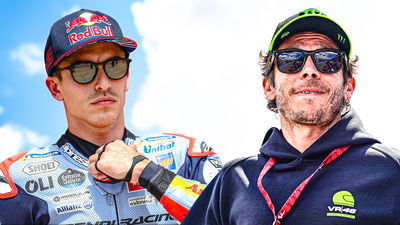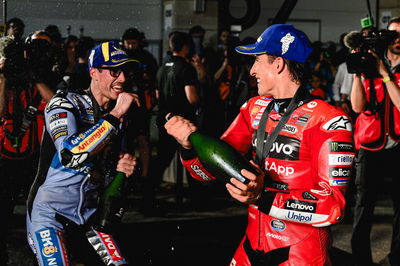Why Yamaha’s rumoured radical MotoGP shift is bigger than just an engine
A touted shift to V4 development for Yamaha is hoped to bring it further up the MotoGP field. But it’s the shift in mentality that will yield its biggest boost

The news that Repsol will be ending its 30-year partnership as the factory Honda squad’s title partner at the conclusion of the 2024 season is one of the biggest examples of just how much the balance of power in MotoGP has shifted in the 2020s.
A once all-conquering empire, Repsol bowing out comes at a point when Honda is arguably at its lowest ebb in the premier class. The fact just five years prior it was world champion in one of the most dominant displays ever by a rider courtesy of Marc Marquez further highlights just how bad things have gotten for the Japanese manufacturers.
Honda’s sole win last year with Alex Rins at COTA remains the the last success for either of the remaining Japanese brands - knocked down from three to two by Suzuki’s shock exit at the end of 2022. For Yamaha, it hasn’t registered a race win of any kind since 2022, where it became apparent that the balance of power had transferred out of Japan’s hands and into those of the European marques.
Ducati, since the end of 2022, has been utterly dominant. It won all but three grands prix in 2023 as it won a second world title with Francesco Bagnaia. And Aprilia’s COTA win aside this year, Ducati hasn’t been knocked off the top step of the podium.
Meanwhile, Honda and Yamaha desperately try to use concessions given to them at the end of last year in a bid to develop their way back up the order.
So far, neither have come close to even getting onto the podium (Quartararo was third before a penalty at the Jerez sprint, though was gifted that by a spate of crashes in front of him). The average gap to first place in each grand prix this year for Yamaha is 25.168s, while for Honda it’s a fair bit worse at 33.229s.
Yamaha, at least, has shown a bit better than Honda in 2024. The Iwata-based marque has reached the top 10 four times on Sundays, while Honda is yet to breach that barrier - and it has two more riders than Yamaha does.
That latter point will change from next year, as Yamaha partners up with Pramac Racing to field Miguel Oliveira and Jack Miller. Yamaha has elected to go for an experienced line-up at Paolo Campinoti’s outfit alongside factory stable Quartararo and Alex Rins to accelerate its bike development in 2025.
While both Yamaha and Honda have been making use of the concession benefits to test in-season with its race riders, the former is the one who seems to be churning out more parts to then bring to grands prix weekends.
It hasn’t yielded any major gains, but various new engine, aero and chassis upgrades have provided small boosts as they’ve been introduced. Honda, having made a seemingly huge stride with the RC213V for the Valencia test last year, quickly found its 2024 concept didn’t work after only a few rounds.
From then it’s been chasing its tail, while a promised radical overhaul of the bike for last Monday’s Misano test didn’t seem to materialise.
“This wasn’t the Misano test I expected,” Mir said after being generally underwhelmed with the progress made with the RC213V. A new aero fairing was met with rave reviews from Luca Marini. But that seemed to the only positive.

Yamaha, meanwhile, didn’t have anything new to try as such because it had evaluated so many different items in private tests. Both Quartararo and Rins sounded happy with the chassis direction, while a 2025 prototype engine raced by Rins at Aragon - where he finished a season-best ninth - but then put away for the San Marino GP allowed the Spaniard a gain in race pace of about 0.5s-0.7s.
It’s not exactly clear why it wasn’t raced again at Misano and whether we’ll see that engine again. But it was a curious comment to come out of the Misano test, given reports that then emerged from es.motorsport.com stating Yamaha was at an advanced stage in building its first V4 engine of the modern era.
Yamaha is the only brand using an inline-four-cylinder engine while the rest run V4s. It’s been a concept that Yamaha has stuck by for the entirety of the modern four-stroke era and one in recent years it has defended as its results declined.
In very basic terms, an inline-four is not as powerful as a V4. But the narrower shape of the inline-four allows more flexibility in chassis design, and therefore those types of bikes tend to have nimbler handling. This was a characteristic of the Suzuki too when it raced in MotoGP with the inline-four.
But Yamaha’s riders this year - particularly Quartararo - have complained about the fact that the M1 doesn’t handle the way it used to. In spite of its power deficit to its rivals, the Yamaha generally remained competitive by having good handling and grip. Now that isn’t the case, altering engine philosophy doesn’t seem like such problematic idea.
Instigating this shift to a V4 is Luca Marmorini, who has worked Yamaha as a consultant on its engines since 2022. Formerly an engine chief for Toyota and Ferrari in Formula 1, Marmorini has helped deliver the M1 more power as requested - but it’s not done much to help an M1 that struggles for rear grip and turning right now.
The move also coincides with MotoGP’s shift to 850cc engines from 2027. In theory, if Yamaha can get a V4 onto the bike for 2025 and develop it in a good way, it should give it a boost when the 2027 regulations come into effect. A rumoured engine development freeze to see out the current regulation cycle will also work in Yamaha’s favour - providing it doesn’t lose concessions based on improved results.
The shift to a V4, if it does come to pass next season, won’t instantly lift Yamaha up the order. But what this philosophy change does signal is a genuine softening of the stubborn Japanese mentality that has long been credited as being the reason both Yamaha and Honda have slid down the order in MotoGP.
Having Marmorini come in as a consultant was a hint at this, as was Max Bartolini’s hiring from Ducati to be Yamaha’s technical chief. But it would have meant nothing without affirmative action from the powers that be in Iwata. Honda, by contrast, had Kalex build it a chassis last year that was quickly discarded by its riders and has since severed ties with the brand.
Shifting from its long-held engine concept will also open the doors to other new avenues Yamaha was perhaps too afraid in the past to explore, which will only aid bike development. Clearly, it has realised that it will never beat Ducati by doing what it has always done. Nor will it get there without being prepared to fail a few times along the way as it steps into the unknown.
Accepting that, though, is the first big step back towards the podium…












